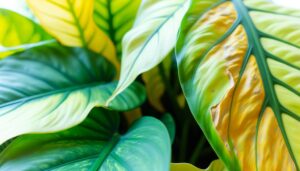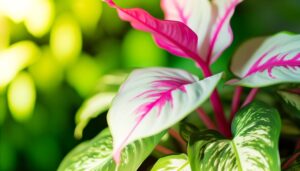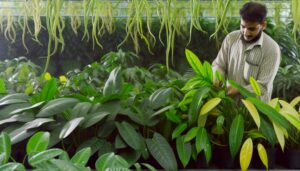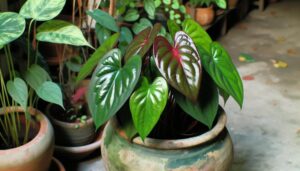What Are the Characteristics of Philodendron Plowmanii 'Black Face'?
Philodendron Plowmanii 'Black Face' showcases extraordinary deep green and almost-black heart-shaped leaves, each measuring up to 30 cm in length and 25 cm in width. The leaves display prominent venation with a shiny, tough texture.
The species features sturdy petioles, up to 20 cm long, emerging from a central rhizome for a compact growth form. Flourishing in temperatures of 18-24ºC and moderate humidity, it requires bright, indirect sunlight and well-draining soil.
Balanced watering is crucial, avoiding waterlogging to prevent root rot. Monthly fertilization with a 20-20-20 NPK fertilizer supports ideal growth.
For a deeper understanding of this plant, explore further.
Key Takeaways
- Heart-shaped leaves with deep green and near-black hues.
- Grows best in bright, indirect sunlight and ambient temperatures between 18-27°C.
- Requires balanced watering and well-draining potting media to prevent root rot.
- Thrives with humidity levels above 60%, ideal for its epiphytic nature.
- Propagates vegetatively through its rhizomatous root system.
Appearance and Foliage
The Philodendron Plowmanii 'Black Face' is distinguished by its strikingly dark, heart-shaped leaves that can reach up to 30 cm in length and 25 cm in width, displaying a unique combination of deep green and near-black hues. Each leaf exhibits pronounced venation, with a texture that is both glossy and leathery.
The petioles, which can extend to 20 cm, are robust and support the substantial foliage. This species' leaves emerge from a central rhizome, providing a compact yet lush appearance. The mature leaves often possess a slight undulation along the margins, adding to the visual interest.
These distinctive characteristics make Philodendron Plowmanii 'Black Face' a notable specimen within the Araceae family, particularly sought after for its ornamental value.
Growth Habits
In addition to its remarkable foliage, Philodendron Plowmanii 'Black Face' exhibits a clumping growth habit, characterized by its rhizomatous root system, which facilitates the formation of dense clusters of leaves.
The rhizomes, typically measuring 1 to 2 centimeters in diameter, enable vegetative propagation and contribute to the plant's compact, bushy appearance. Unlike vining Philodendron species, P. Plowmanii 'Black Face' maintains a terrestrial growth form, spreading horizontally rather than vertically.
The petioles are robust, often reaching lengths of up to 30 centimeters, supporting the large, heart-shaped leaves. This species thrives under a relatively consistent temperature range of 18-24°C, with moderate humidity levels, optimizing its growth rate.
Such growth habits make it an attractive specimen for both indoor and outdoor cultivation.
Care Requirements
Best care for Philodendron Plowmanii 'Black Face' requires maintaining a stable environment with indirect light exposure, consistent moisture levels, and well-draining soil. The substrate should consist of a mix including peat moss, perlite, and orchid bark in a ratio of 2:1:1 to ensure ideal aeration and drainage.
Watering should be done when the top 2-3 cm of the soil feels dry to touch, avoiding waterlogging which can lead to root rot (Pythium spp.). Humidity levels should be kept between 60-70%, utilizing a humidifier if necessary.
Fertilize monthly during the growing season with a balanced, water-soluble fertilizer (20-20-20 NPK). Regular monitoring for pests such as aphids and spider mites is crucial to maintain plant health.
Light and Temperature
Maintaining ideal light and temperature conditions for Philodendron Plowmanii 'Black Face' involves providing bright, indirect sunlight and maintaining ambient temperatures range between 18°C and 27°C (64°F and 80°F).
This tropical species, native to the rainforests of South America, thrives under dappled sunlight, simulating its natural understory habitat. Direct sunlight can cause leaf scorch, while insufficient light may hinder growth and color vibrancy.
Temperature fluctuations outside the specified range can lead to physiological stress, impacting growth rates and overall plant health. Relative humidity levels should remain above 60%, as lower humidity can result in brown leaf tips.
Watering Needs
Proper watering is necessary for the Philodendron Plowmanii 'Black Face,' requiring a balanced approach to maintain soil moisture without causing waterlogging. Ideal hydration involves watering once the top 2-3 centimeters of the substrate dry out, ensuring that the root zone remains uniformly moist.
Overwatering can lead to root rot (Phytophthora spp.) and other pathogenic issues, while underwatering may result in desiccation and leaf necrosis. Utilizing well-draining potting media aids in preventing water accumulation. Additionally, water quality is essential; use dechlorinated or rainwater to avoid chemical buildup.
Ambient humidity levels should be maintained between 60-80% to support the plant's epiphytic nature. Consistent monitoring of soil moisture using a hygrometer can help achieve best hydration conditions.
Soil and Fertilization
In cultivating Philodendron Plowmanii 'Black Face,' an ideal soil composition incorporates a blend of peat, perlite, and orchid bark to ensure sufficient aeration and drainage. A balanced mixture of 40% Sphagnum peat moss (Sphagnum spp.), 30% perlite (expanded volcanic glass), and 30% orchid bark (fir bark) guarantees an ideal substrate. This combination allows the roots to breathe while retaining necessary moisture.
Fertilization should be administered using a balanced liquid fertilizer, such as a 20-20-20 NPK formula, diluted to half strength every four weeks during the growing season (spring to early autumn). Avoid over-fertilization, as excessive nutrients can lead to root burn and foliage damage.
Maintaining proper soil and nutrient management is essential for the health and vigor of Philodendron Plowmanii 'Black Face.'
Origins and History
Philodendron plowmanii 'Black Face' was first described and classified by botanists who recognized its distinctive morphological traits.
Native to the tropical rainforests of South America, particularly in regions of Ecuador and Peru, this species thrives in high humidity and shaded environments.
Its horticultural significance is underscored by its unique phenotypic characteristics, making it a prized specimen among collectors and researchers.
Discovery and Naming
Discovered in the dense rainforests of South America, Philodendron plowmanii 'Black Face' was meticulously cataloged by botanists who recognized its unique morphological characteristics and potential horticultural value. This Philodendron species was named in honor of Dr. Timothy Plowman, a renowned botanist known for his work on the ethnobotany of the region. The epithet 'Black Face' refers to the distinctive dark pigmentation on the petioles and leaf surfaces.
| Aspect | Details |
|---|---|
| Discoverer | Dr. Timothy Plowman |
| Discovery Year | 1970s |
| Naming Origin | Unique dark pigmentation, honoring Plowman |
The detailed cataloging involved the analysis of leaf morphology, petiole structure, and pigmentation patterns, ensuring accurate classification within the Philodendron genus. This meticulous process highlighted its potential for both scientific study and ornamental use.
Native Habitat
Nestled within the tropical rainforests of the Amazon Basin, the native habitat of Philodendron plowmanii 'Black Face' is characterized by high humidity, consistent rainfall, and temperatures averaging between 20°C to 30°C.
This species thrives in the understory of dense forests, where it experiences diffused sunlight and nutrient-rich, well-drained soils. The ecosystem provides an ideal microclimate with relative humidity levels often exceeding 80%, vital for the plant's physiological processes.
Philodendron plowmanii 'Black Face' typically grows as a hemiepiphyte, initially rooting in the soil before climbing trees for support. This natural adaptation allows it to access higher light levels while benefiting from the humid, stable environment provided by the forest canopy.
Horticultural Significance
The horticultural significance of Philodendron plowmanii 'Black Face' can be traced back to its initial collection and classification by botanists studying the rich biodiversity of the Amazon Basin.
This cultivar, a standout within the Araceae family, showcases unique phenotypic characteristics, including deeply veined, heart-shaped leaves measuring up to 30 cm in length. Its dark, almost black petioles and leaf undersides provide a striking contrast, making it highly sought after in ornamental horticulture.
First documented in the late 20th century, Philodendron plowmanii 'Black Face' has since become a staple for collectors and horticulturists. Its adaptability to various humidity levels and indirect light conditions further underscores its importance in both botanical study and decorative use.
Conclusion
Philodendron plowmanii 'Black Face' stands as an unparalleled marvel in botanical cultivation, boasting iridescent foliage and vigorous growth habits that defy conventional horticultural parameters. Its meticulous care requirements, encompassing precise light, temperature, and watering conditions, underscore its stature as a horticultural gem.
Originating from verdant tropical regions, this specimen's unique characteristics demand both respect and admiration. The unparalleled allure of Philodendron plowmanii 'Black Face' renders it an indispensable addition to any serious plant collection, embodying horticultural excellence.






